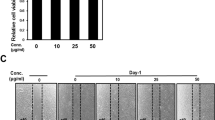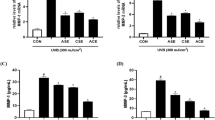Abstract
The aim of this study was to investigate the role of tetrahydrocurcumin (THC) against various skin health parameters using in vitro human foreskin fibroblast and melanoma cell lines (i.e. HFF-1 and B16-F10). The study was assessed using cell viability by MTT assay, identification of extracellular matrix component in HFF-1 cell line (i.e. collagen, elastin and hyaluronic acid), melanin synthesis in B16-F10 cells, cell viability against UVB-induced stress in HFF-1 cells, and in vitro wound healing by the scratch assay. THC was found to be safe and nontoxic up to the concentration of 10 µg/mL with improved level of collagen (37.90%), elastin (90.1%), and hyaluronic acid (74.19%) at 1 µg/mL. Besides, melanin was significantly inhibition by 78.5% at the lowest THC concentration of 0.1 µg/mL. UVB-protection rate was significantly improved by 61.2% and improved cell viability by THC in HFF-1 cells, which indicated protection from photoaging. In addition, THC showed significant wound healing activity (78.51%) and greater migration of fibroblast in HFF-1 cells at different time period. It can be concluded from the study that THC can protect the skin matrix with improved extracellular component synthesis and would healing via collagen synthesis in the skin, which improved the skin elasticity and tightness. Overall, it might be suggested that THC can be used as a safe skin whitening agent, wounds management, cosmetic applications, and treating various skin-related disorders.






Similar content being viewed by others
References
Aggarwal BB, Deb L, Prasad S (2015) Curcumin differs from tetrahydrocurcumin for molecular targets, signaling pathways and cellular responses. Molecules 20:185–205
Akbik D, Ghadiri M, Chrzanowski W, Rohanizadeh R (2014) Curcumin as a wound healing agent. Life Sci 116:1–7
Arct J, Ratz-Łyko A, Mieloch M, Witulska M (2014) Evaluation of skin colouring properties of curcuma longa extract. Indian J Pharm Sci 76:374–378
Busca R, Ballotti R (2000) Cyclic AMP a key messenger in the regulation of skin pigmentation. Pigment Cell Res 13:60–69
Chanchal D, Swarnlata S (2008) Novel approaches in herbal cosmetics. J Cosmet Dermatol 7:89–95
Frantz C, Stewart KM, Weaver VM (2010) The extracellular matrix at a glance. J Cell Sci 123:4195–4200
Fronza M, Heinzmann B, Hamburger M, Laufer S, Merfort I (2009) Determination of the wound healing effect of Calendula extracts using the scratch assay with 3T3 fibroblasts. J Ethnopharmacol 126:463–467
Gao XH, Zhang L, Wei H, Chen HD (2008) Efficacy and safety of innovative cosmeceuticals. Clin Dermatol 26:367–374
Gupta SC, Patchva S, Koh W, Aggarwal BB (2012) Discovery of curcumin, a component of golden spice, and its miraculous biological activities. Clin Exp Pharmacol Physiol 39:283–299
Hahn MS, Kobler JB, Starcher BC, Zeitels SM, Langer R (2006) Quantitative and comparative studies of the vocal fold extracellular matrix. I: elastic fibers and hyaluronic acid. Ann Otol Rhinol Laryngol 115:156–164
Helmstädter A, Staiger C (2014) Traditional use of medicinal agents: a valid source of evidence. Drug Discov Today 19:4–7
Ho JN, Lee YH, Lee YD, Jun WJ, Kim HK, Hong BS, Shin DH, Cho HY (2005) Inhibitory effect of Aucubin isolated from Eucommia ulmoides against UVB induced matrix metalloproteinase-1 production in human skin fibroblasts. Biosci Biotechnol Biochem 69:2227–2231
Hosoi J, Abe E, Suda T, Kuroki T (1985) Regulation of melanin synthesis of B16 mouse melanoma cells by 1 alpha, 25-dihydroxyvitamin D3 and retinoic acid. Cancer Res 45:1474–1478
Lai CS, Wu JC, Yu SF, Badmaev V, Nagabhushanam K, Ho CT, Pan MH (2011) Tetrahydrocurcumin is more effective than curcumin in preventing azoxymethane-induced colon carcinogenesis. Mol Nutr Food Res 55:1819–1828
Liang CC, Park AY, Guan JL (2007) In vitro scratch assay: a convenient and inexpensive method for analysis of cell migration in vitro. Nat Protoc 2:329–333
Naito M, Wu X, Normura H, Kodama M, Kato Y, Osaswa T (2002) The protective effect of tetrahydrocurcumin on oxidative stress in cholesterol-fed rabbits. J Atheroscler Thromb 9:243–250
Plumb JA (2004) Cell sensitivity assays: the MTT assay. Methods Mol Med 88:165–169
Rozario T, DeSimone DW (2010) The extracellular matrix in development and morphogenesis: a dynamic view. Dev Biol 341:126–140
Wattanakrai P, Suwanachote S, Kulkollakarn S, Rajatanavin N (2007) The study of human skin irritation of a novel herbal skin care product and ingredients by human single closed patch testing. J Med Assoc Thail 90:1116–1122
Weindl G, Schaller M, Schäfer-Korting M, Korting HC (2004) Hyaluronic acid in the treatment and prevention of skin diseases: molecular biological, pharmaceutical and clinical aspects. Skin Pharmacol Physiol 17:207–213
Wen KC, Shih IC, Hu JC, Liao ST, Su TW, Chiang HM (2011) Inhibitory effects of Terminalia catappa on UVB-Induced photodamage in fibroblast cell line. Evid Based Complement Alternat Med 2011:904532
Wu JC, Tsai ML, Lai CS, Wang YJ, Ho CT, Pan MH (2014) Chemopreventative effects of tetrahydrocurcumin on human diseases. Food Funct 5:12–27
Zhang L, Yoshida T, Kuroiwa Y (1992) Stimulation of melanin synthesis of B16-F10 mouse melanoma cells by bufalin. Life Sci 51:17–24
Acknowledgements
The authors extend their sincere thanks and grateful to Dabur Research Foundation, India for providing the facilities and support that enabled the successful completion of the work. Further, the authors report no conflicts of interest in this work. However, no external funding is associated with this study.
Author information
Authors and Affiliations
Corresponding author
Ethics declarations
Conflict of interest
The authors state no conflict of interest.
Rights and permissions
About this article
Cite this article
Trivedi, M.K., Gangwar, M., Mondal, S.C. et al. Protective effects of tetrahydrocurcumin (THC) on fibroblast and melanoma cell lines in vitro: it’s implication for wound healing. J Food Sci Technol 54, 1137–1145 (2017). https://doi.org/10.1007/s13197-017-2525-8
Revised:
Accepted:
Published:
Issue Date:
DOI: https://doi.org/10.1007/s13197-017-2525-8




